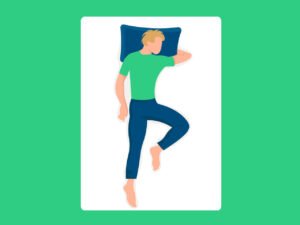
Skin wrinkles are an inevitability of age.
Wrinkles like laughter lines can showcase our personality, but many people would still prefer to limit the number of wrinkles that they develop.
While many wrinkles are caused by the repeated facial expressions that we make, you may not realize that some wrinkles, such as sleep lines on forehead, can be caused by how we sleep.
You can take steps to prevent them or reduce their appearance if you already have them.
Read on to find out everything you need to know about sleep lines and what to do about them.
Contents
What Causes Wrinkles?
Your skin is the largest organ in your body.
It is essential both for keeping your internal organs safe and unexposed from the elements and for regulating your body’s internal environment (homeostasis).
It is part of your immune system, preventing illness-causing pathogens from entering your body, and it is packed full of nerve endings that help you experience the world and warn you of danger.
It can help you to cool down when you’re hot, and it provides a water-resistant barrier.
In short, your skin is amazing.
On a day-to-day basis, however, what most of us notice about our skin is its appearance.
And one of the elements of our skin’s appearance that many of us worry about is wrinkles.
Wrinkles are a natural part of the aging process, and they occur because the skin’s mechanical properties change as we age.[1]
The upper dermis layer of the skin becomes thinner and less elastic, which means that its ability to return to its original position after being wrinkled reduces.
There is also a loss of collagen in the middle dermis layer of the skin, affecting the skin’s structural integrity, causing it to sag.
There are two main types of wrinkles:
- Dynamic wrinkles – these are wrinkles that are caused by repetitive movements, such as laughing and frowning, and they appear at the places where the skin folds after making these facial expressions. When we are younger, the wrinkles disappear as soon as we stop making the expression but as we age the wrinkles become permanent.
- Wrinkles caused by age – some wrinkles are not caused by dynamic movement but because of forces like gravity that pull on the skin as we age. They tend to not be in places that are folded when we make facial expressions and can include sleep wrinkles.
How Are Sleep Lines Formed?
At first glance, it seems odd that sleeping should cause wrinkles.
After all, our faces aren’t dynamic when we are asleep, so there’s no reason for the skin to fold.
The answer is simple – our pillows cause them.
When we sleep on our sides or our front, the face is pressed into our pillows’ fabric, which exerts forces on our skin that can cause wrinkles.
These forces include:[2]
- Compression – this is the force of gravity pressing your face into the pillow.
- Tension – this is the force of the pillow pressing into your face.
- Shear – this is the force pulling across the pillow as you move in the night.
These forces distort our faces while we sleep, and, over time and as we age, they begin to cause permanent wrinkles in the skin to form.
Sleep wrinkles can be distinguished from expression wrinkles because they are not in areas of the skin that tend to be distorted by facial expressions, and they tend to form in parallel lines, often two or three together.
They are most often located at the temple, near the back of the eye socket area, the forehead, and the cheek.[3]
Can Sleep Lines On Forehead Be Prevented?
Sleep lines fall on the face differently from expressive wrinkles, and they are less in keeping with our personality and how our face moves.
For these reasons, many people are keen to try and prevent sleep wrinkles as much as possible, and there are lots of steps that you can take to try and stop them from occurring in the first place and reduce them once they have formed.
So let’s take a look at some of those actions:
1) Changing your sleep position can reduce sleep lines
Sleep lines only form when our faces are pressed up against our pillow.
So if you tend to sleep on your front (prone) or your side, you are at much greater risk of developing sleep lines.
However, if you sleep on your back, sleep lines won’t form because your face isn’t pressed up against anything at all.
But what can you do if you are a natural side or stomach sleeper?
While it can be difficult to change your natural sleep position, it isn’t impossible.
You can train yourself to become a back sleeper in a variety of ways:
- Use a firmer mattress to support your back and make it more comfortable to sleep in a supine position.
- Use a wedge pillow or YourFacePillow to keep you on your back.
- Put a pillow under your knees to reduce the pressure on your lower back and prevent you from rolling over in the night to reduce the pressure.
- Place pillows along each side of your body to block you from rolling over.
This advice isn’t just useful for side or stomach sleepers. Even if you tend to go to sleep on your back, you will probably move around in the night and spend at least some time in a side or stomach position. And, as we age, we tend to move around less and spend more time in each position through the night. So you might well be spending more time with your face scrunched up against your pillow than you realize.
2) Changing your pillowcase can reduce sleep lines
Most of us use cotton pillows.
They are soft, breathable, and easy to clean, but they also exacerbate sleep lines and wrinkles.
Cotton is quite abrasive, and when your face moves across it, there is a fair amount of traction pushing back into your skin.
An easy fix is to use a silk pillowcase.
A silk pillowcase is smooth, and it won’t scrunch up against your face in the same way that a cotton pillow does.
Instead, your skin will glide across it as you move.
A silk pillowcase also won’t soak up the moisture from any night creams or oil that you use (more on them later), meaning that they will stay on your skin longer so that they can do their job.
It won’t form stiff creases that can indent in your skin, and it is a better temperature regulator to get less sweating.
3) Use a mask to prevent sleep lines on forehead
If you’re not 100% confident that you’ll be able to stay on your back all through the night and/or you don’t want to use a silk pillowcase, or you just want a bit more protection, there are Anti-Aging Sleeping Masks that will help to prevent sleep lines from appearing.
These masks are designed to cover your entire forehead, and they work by creating a barrier between your forehead and your pillow so that when your face moves against it, the skin underneath the mask isn’t wrinkled up.
These masks tend to be made of satin or silk, so your skin won’t wrinkle up against them.
They’re a low-effort and effective way to give yourself that little bit of extra protection from sleep lines.
4) Use retinol to reduce sleep lines that have already appeared
If you are already dealing with sleep lines, all is not lost.
You can actually turn back time and make at least some of those wrinkles disappear.
Retinol is the darling of the skincare world, and with good reason.
It has been shown in various clinical studies to be effective at reducing signs of aging in the skin, including wrinkles.[4]
Retinol is a form of vitamin A.
Unlike many other skincare products that work by removing dead skin cells from the outermost layer of the skin, retinol goes a lot deeper and actually changes the skin from the lower layers up.
It increases the amount of collagen and elastin and thickens the layer of skin where wrinkles begin.
And they also trigger a more rapid turnover of skin cells, increasing the number of new skin cells created.
All of this together means that your skin literally becomes younger.
Retinol is more effective at reducing wrinkles in photoaged skin, which is skin that has prematurely aged through exposure to sunlight.
It won’t stop your skin from aging altogether, but it can make your skin look as though it has never been damaged at all, and you will have fewer wrinkles (including sleep lines) as a result.
It is important to remember with retinol that the results aren’t instantaneous.
In fact, it can take six months to a year for you to see its most optimal results, so this really is a product for the long term.
5) Hyaluronic acid can help to reduce sleep lines on forehead
Hyaluronic acid is another great product to add to your skincare routine if you want to reduce sleep lines.
It helps to plump up the skin, and it is an amazing moisturizer – it absorbs up to 1000 times its weight in water!
It draws in water from the environment to moisturize your skin deeply, so it can help to make your skin look younger and prevent it from drying out.
If you want to take things a step further, you can also have hyaluronic acid-based fillers injected directly into your sleep lines.
Hyaluronic acid is injected directly into the dermal layer, instantly plumping up the skin and reducing the appearance of lines and wrinkles.
They effectively treat sleep lines, but they are temporary, so regular treatments are needed, usually every 6-9 months.
Hyaluronic acid naturally occurs in the body.
It is a lubricant and shock absorber in the joints, and it helps regulate the movement of water throughout the skin.
So using hyaluronic acid skin products or fillers is a way of giving your body an extra boost of a nutrient that it already has.
Botox won’t work for sleep lines
Unfortunately, you are out of luck if you have considered getting Botox treatment to reduce your sleep lines.
Botox is a muscle relaxer. It works by blocking the nerve signals to the muscles in certain areas of your face, relaxing them.
It makes it an effective treatment for dynamic wrinkles caused by repetitive facial expressions because it relaxes exactly those muscles that cause the wrinkles.
But sleep lines are not caused by the movement of muscles in our face.
They are caused by external forces that have created folds in the skin, and these aren’t connected to the movement of any muscle in the face.
So Botox treatment won’t do anything to treat or prevent them.
Fillers, such as hyaluronic acid fillers, which directly plump the wrinkles up, are a much more effective way of reducing sleep lines.
The Bottom Line
Sleep lines on forehead can be aggravating.
They can appear in areas of your face that you wouldn’t expect expressive wrinkles so that they can look quite jarring.
They are caused by the forces imposed on your facial skin when it is pressed up against your pillow, creating folds in the skin that, over time, develop into wrinkles.
You can prevent sleep lines and wrinkles by sleeping on your back, using a silk pillow, wearing a forehead mask, using retinol and hyaluronic acid in either serum or filler form.
Botox is not an effective treatment for sleep lines because the movement of muscles doesn’t cause them.



